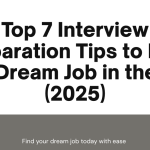A well-crafted resume is your gateway to landing interviews and ultimately securing a job in the competitive US employment market. In 2025, recruiters increasingly rely on applicant tracking systems (ATS) and digital screening tools, so understanding how to prepare an effective resume is crucial.
This guide covers the essential components, formatting tips, and common mistakes to avoid, helping you create a resume that stands out to both automated systems and human recruiters.
1. Understand the ATS System
Most US employers use Applicant Tracking Systems (ATS) to filter resumes before a recruiter reviews them. ATS software scans for keywords related to the job description and ranks applicants accordingly.
Tips to optimize for ATS:
- Use standard section headings like “Work Experience,” “Education,” and “Skills.”
- Include keywords and phrases from the job listing naturally.
- Avoid images, graphics, and complex tables.
- Submit resumes in .docx or PDF formats unless specified otherwise.
2. Choose the Right Resume Format
There are three main resume formats:
- Chronological: Lists your work experience from most recent to oldest. Ideal for steady career progression.
- Functional: Focuses on skills and competencies rather than dates. Good for career changers.
- Combination: Mixes chronological and functional, highlighting skills and experience.
For most US jobs, the chronological format is preferred unless you have gaps or are switching industries.
3. Essential Resume Sections
- Contact Information: Full name, phone number, email, and LinkedIn profile link.
- Professional Summary: A 2-3 sentence overview highlighting your expertise and career goals.
- Work Experience: List your most relevant jobs, including company names, dates, and bullet points describing achievements using action verbs.
- Education: Degrees, institutions, and graduation dates.
- Skills: Technical and soft skills relevant to the position.
- Certifications & Awards: Include if applicable.
4. Tailor Your Resume for Each Job
Customize your resume for every application by emphasizing the most relevant skills and experiences. This increases your chances of passing ATS and appealing to recruiters.
5. Common Resume Mistakes to Avoid
- Spelling and grammatical errors
- Using vague descriptions (e.g., “responsible for”)
- Including irrelevant information
- Overly long resumes (ideally 1-2 pages)
- Unprofessional email addresses
Conclusion
Crafting an effective resume takes time but is essential for job hunting success in the USA. By optimizing your resume for ATS, using the right format, and tailoring it for each job, you improve your chances of getting noticed and called for interviews.
Frequently Asked Questions (FAQ)
Q1. How long should my resume be for US job applications?
A: Ideally, 1 page for early-career professionals and up to 2 pages for those with extensive experience.
Q2. Should I include a photo on my resume?
A: No. Photos are generally discouraged in the US to avoid unconscious bias.
Q3. What file format should I submit my resume in?
A: Unless otherwise specified, PDF or .docx are the safest formats accepted by most ATS.
Q4. How can I find keywords to include in my resume?
A: Carefully analyze the job description and use the exact phrases and skills mentioned.
Q5. Should I include references on my resume?
A: It is usually best to omit references. Instead, prepare a separate document and provide references upon request.
Looking to boost your job search with premium tools and resources?
Click here to discover exclusive USA job assistance!
Start accelerating your career today!


